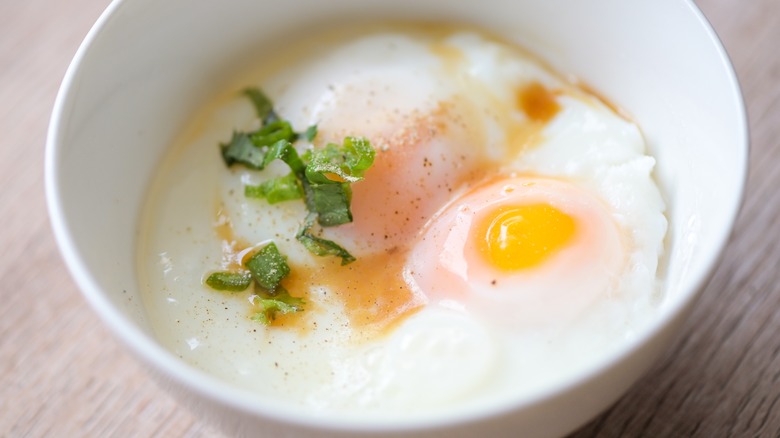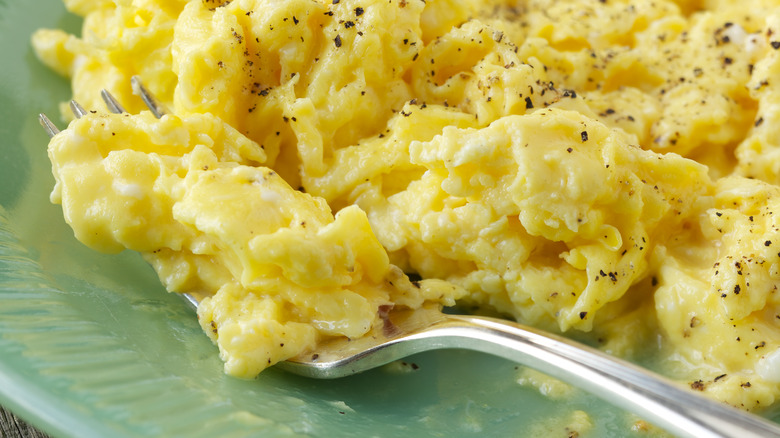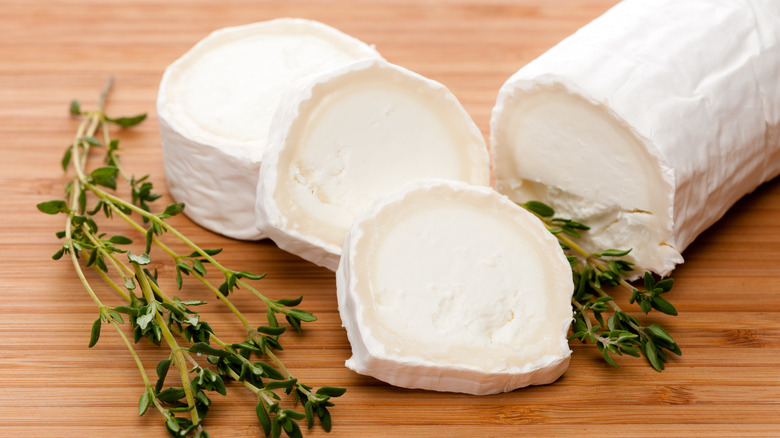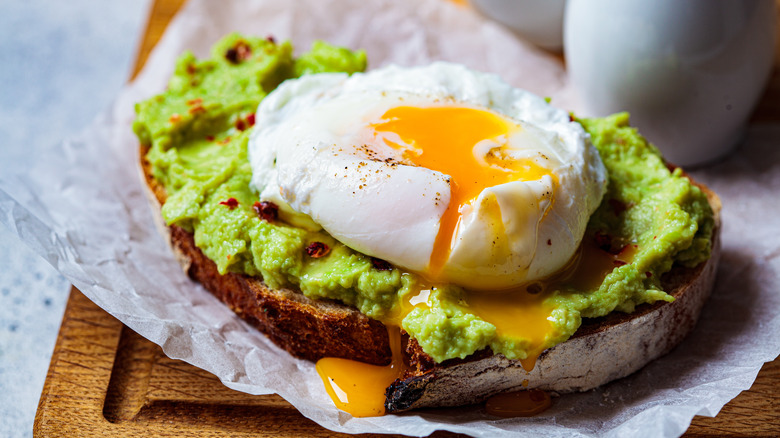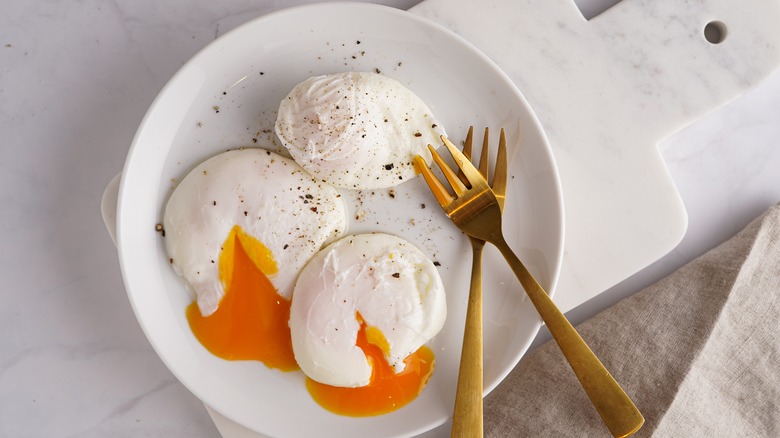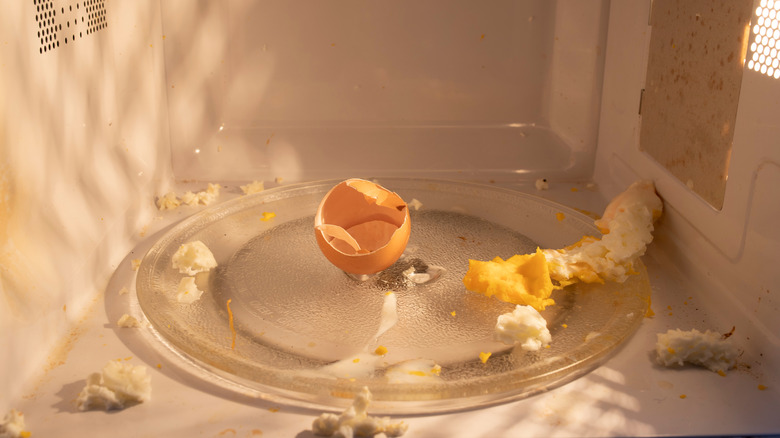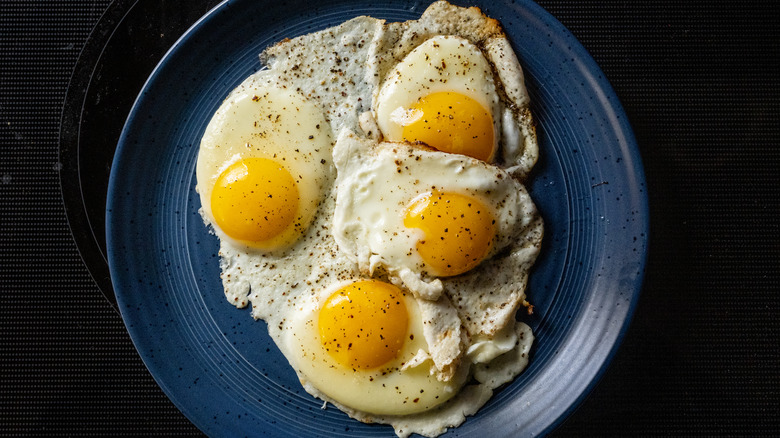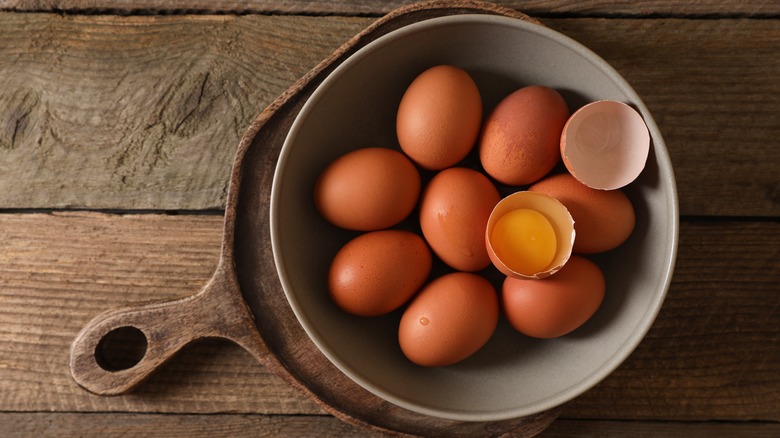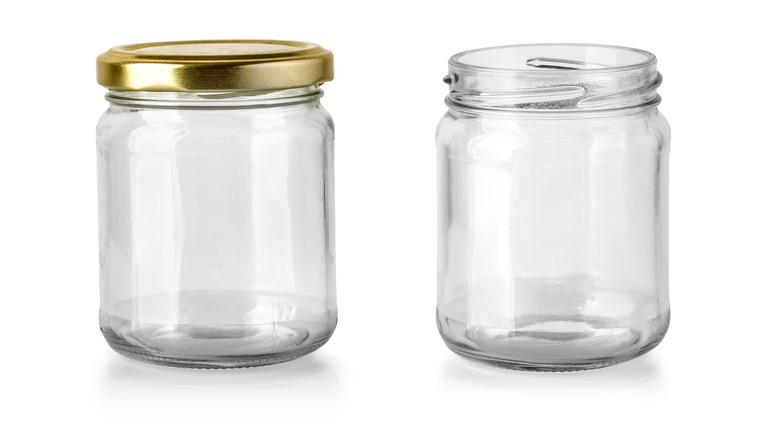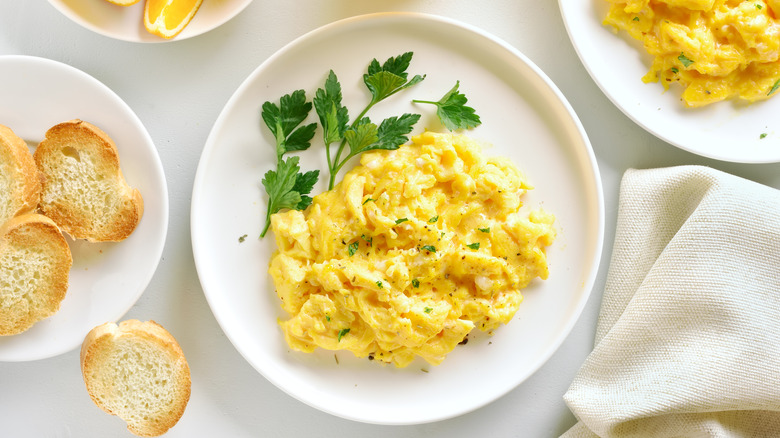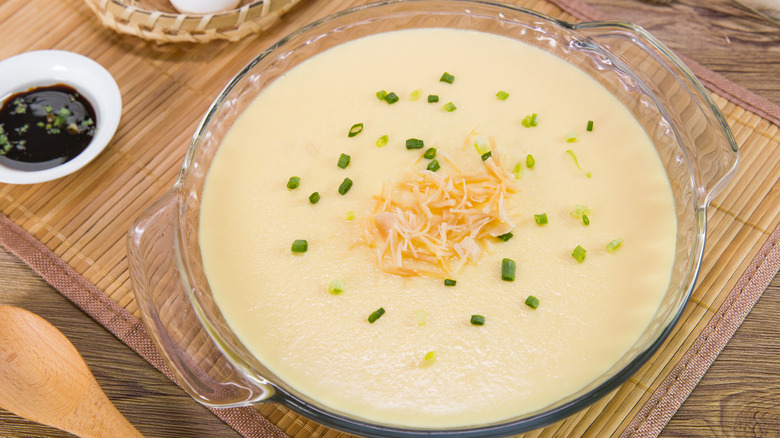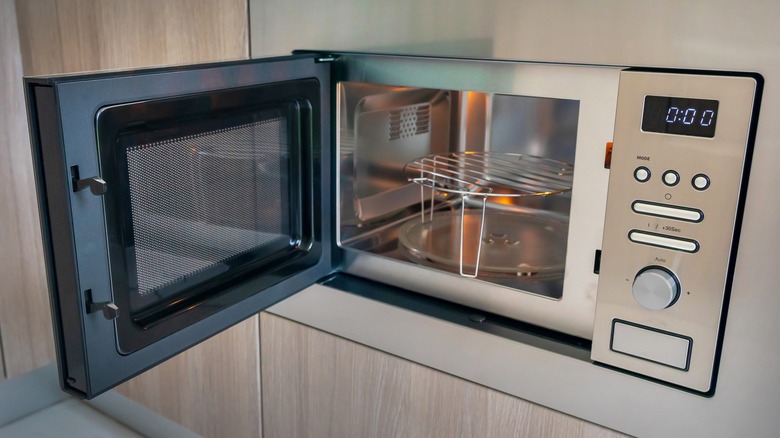13 Expert Tips For Cooking Eggs In The Microwave
Eggs are one of those foods that can be cooked in a million different ways but, for some reason, cooking them in the microwave remains something that many folks turn their nose up at. The truth, though, is that microwaving eggs is both faster and more energy-efficient than using an oven or a stovetop, and usually results in a lot less cleaning up afterward. Cooking eggs in the microwave is also usually way more hands-off than frying or poaching them, while still giving you a similar result. Additionally, microwaving eggs may present you with nutritional advantages, as its speed and need for less liquid means that your eggs may lose fewer nutrients than if you're using other cooking styles.
You don't have to limit yourself to one style of egg if you're using the microwave, either: Poached, scrambled, and even fried eggs are entirely achievable using the appliance. But if you've never microwaved eggs before, we can understand a little trepidation around it. That's why we decided to collect our favorite tips. Drawing from a raft of knowledge from egg-xperts (sorry, we couldn't resist), including celebrity chefs, egg producers, and even scientists, we found some of the best suggestions out there for how to make microwaved eggs flavorful and perfectly cooked.
1. Before you begin, grab the right cookware
Cooking eggs in the microwave requires an entirely different set of cookware than if you were to cook them on the stovetop. The first thing you'll need to do is assess whether your equipment is microwave-safe so that it doesn't crack or shatter midway through your cooking process. You can use plastic Tupperware here if you wish, but you can also use pretty much anything you'd use to serve food in, like ramekins, mugs, or bowls. Just be sure to check the base of any crockery you're using carefully, to see if there are specific instructions for the microwave.
Bear in mind, of course, that different-shaped items will be better suited for different egg preparation styles. If you're poaching eggs, for example, you'll want a fairly deep vessel, so that the egg can be surrounded by water — but not so deep or wide that the egg can't heat up quickly. To poach eggs in the microwave, chef John Mielle simply uses a regular teacup (via YouTube). If you're making a fried egg, on the other hand, you'll want a cooking vessel that's wide and flat enough to achieve the correct shape.
2. Always grease your cooking container
If you try and cook eggs in an ungreased pan, unless it has a nonstick surface, it will likely end up adhering itself to the metal. The same thing happens when you try and microwave eggs. Eggs stick to pans and cooking utensils because the proteins in them create a bond with the harder material. If you don't create a barrier between the two with a healthy amount of fat, you'll never be able to remove the cooked eggs intact.
That's why you should always grease your cooking dish before microwaving eggs, per Egg Farmers of Canada. You can do this with pretty much any fat you have to hand, although cooking spray may be the easiest option if you're using a vessel that's small or awkwardly shaped, as you'll achieve better coverage. You can also pour a little bit of vegetable oil onto some paper towel and wipe it around the dish, or use a smidge of butter; remember, adding fat also gives you a chance to add crucial flavor to your eggs. This is especially important if you're making microwaved fried eggs, which rely on additional fat to generate improved texture and that indulgent taste.
3. For microwave scrambled eggs, make sure you stir
A large part of the appeal of scrambled eggs is their texture. When cooked right, the egg dish turns into a steaming, moist pile of bite-sized curds, which are formed by stirring them regularly. This can be slightly trickier if you're cooking them in the microwave, as the closed door prohibits you from sticking your spoon into them every five seconds — but it's essential you find moments to stir them, otherwise, you'll simply end up with a solid mass of egg.
Microwave scrambled eggs generally need around 90 to 120 seconds in a microwave operating at 70% power, and during that, Egg Farmers of Canada advises that you should aim to stir them a good few times. To make life easier, try blasting your eggs in 30-second intervals, stirring them lightly after each period. Stirring your eggs won't just break them up, but will ensure that the heat is distributed amongst them, giving them an even cook throughout. Bear in mind that the more you stir them, the smaller your egg curds will be. If you prefer smaller pieces, beat them more vigorously with a fork, whereas to retain their shape, fold your eggs using a spatula.
4. Add extra ingredients to your scrambled eggs to increase their creaminess
One of the joys of scrambled eggs is that you can fold a huge variety of ingredients into them to improve their texture or flavor, but this can become way trickier in the microwave when you don't have ready access to your eggs. When microwaving eggs, they're also not able to soak up any of the melted butter you'd normally use to cook them in, potentially leaving you with a tasteless dish.
You can prevent this from happening by adding additional ingredients before you cook your eggs, as Gordon Ramsay suggests. Before Ramsay's eggs are cooked, he cubes up pieces of butter and stirs them directly into the mixture (via YouTube). This ensures that during cooking, every piece of egg is coated in creamy fat. While Ramsay's method is designed for the pan, it's also a surefire way to imbue microwaved scrambled eggs with flavor from the inside.
You can also add a hint of tang alongside some creaminess by using goat cheese, just like Bobby Flay does. Simply tear off a few bitesize pieces, and mix them thoroughly with your eggs before microwaving. The goat cheese will melt, giving the eggs a luxurious, complex flavor.
5. To microwave poached eggs effectively, add vinegar
Poaching eggs in the microwave is a quick fix to a big problem. On the stove, poaching eggs traditionally calls for a large pot of swirling water, in which your egg, more often than not, may fall apart and turn stringy. By microwaving poached eggs in a mug, though, you drastically reduce the amount of water and the space for the egg to move around in, leaving it perfectly formed.
However, for the best poached eggs, do what celebrity chef Curtis Coles does, and add white vinegar (via YouTube). This isn't for flavor but for texture. As the Victoria University of Wellington's associate professor Robert Keyzers explains, "Vinegar is an inherently acidic material, so if we add a few drops of vinegar into that boiling water that is going to increase the rate of denaturing and it's going to make that happen faster and help the poached egg hold its shape better." In other words, the vinegar helps the outside of the egg white cook more quickly, binding it around the yolk more effectively and stopping it from spreading out around the pan. Importantly, you don't need too much here, especially considering you'll be microwaving your eggs in a small amount of water. A dash or two will suffice — any more, and you'll just make your eggs taste vinegary.
6. Different parts of your egg will cook at different times
Eggs are, of course, made up of two main parts, the white and the yolk. While the contrast between a firm white and an oozing, luxurious yolk is part of the appeal of an egg, that very same contrast can create problems. Yolks contain basically all of the egg's fat, and when they're microwaved, this fat will cook much faster than the protein-rich whites, per British Lion Eggs. This is largely because when they're cracked and microwaved, they have greater access to immediate heat — unlike if they're being boiled, for example, where the white creates a buffer around the yolk, preventing it from heating up first.
The best way to counteract this is to beat your eggs thoroughly. While this naturally won't work for certain cooking styles, such as if you're making a poached or fried egg in the microwave, combining them thoroughly is the easiest method for cooking them consistently throughout. If you do opt for poaching or frying, however, make sure you're checking your eggs regularly, to avoid overcooking the yolk by mistake.
7. Avoid placing an intact egg in the microwave
There are certain cooking styles that work very well for eggs in the microwave, and certain cooking styles that don't. Boiling is one of the latter. Trying to make a hard-boiled or soft-boiled egg in the microwave, by placing it directly in the machine with the shell intact, will cause it to explode. Microwaving an egg in its shell will heat the inside of it rapidly, and the water inside will quickly turn to steam. With nowhere else to go, this steam will create near-immediate pressure in the egg, making it pop.
The best way to avoid this is simple: Get rid of the shell. You can still make a good approximation of a boiled egg by cracking it whole into a small ramekin and popping it on high for 40 seconds, reducing the time by 10 seconds for a soft-boiled egg. Some people advise that microwaving eggs in their shells is possible if you use a needle to puncture the shell and the yolk before doing so, but bear in mind that this doesn't completely eliminate the risk of it exploding. We would recommend avoiding the risk altogether by saving your boiled eggs for the stove.
8. To microwave a fried egg, use the right bowl
While some egg styles make sense in the microwave, others, like fried eggs, might be harder to conceive of. The truth is, though, that it's entirely possible, and while you may not get a super-crispy edge or much browning, you can still make a McMuffin-style fried egg with ease. The main thing you need for this is a correctly shaped bowl, as celebrity chef David Chang shows via Instagram.
Chang starts by greasing a fairly shallow bowl with cooking spray and cracking an egg into it. He then places his bowl in the microwave for 90 seconds at 30% power. When the egg is pulled out, it's fully cooked, and is virtually indistinguishable from the skillet-fried version, thanks to the shape of the bowl giving it its flatness and width.
This method is arguably much better for fried eggs that you're planning to place in a sandwich with other, crispier elements, as they're noticeably lacking in the kind of crunch or browning that you'd get from frying them. It's also crucial to remember that while it might make sense to use a flat plate here, a bowl with a gentle curve will keep your egg, and its yolk, more central. If your plate is too flat, your egg will just spread all over it, leaving you with an unsightly mess.
9. For smaller eggs, adjust your cooking time
No two eggs are quite the same, and by extension, this means that no two eggs can be cooked in exactly the same way. This is especially true when you're using a microwave. Microwaving eggs cooks them incredibly quickly, and trying to use your regular timings with a smaller-than-usual egg will leave it overdone.
Therefore, you should always adjust your timings if you're cooking smaller or larger eggs in the microwave, as British Lion Eggs advises. While this isn't an exact science, it's best to start by reducing or increasing your original time by 10-second increments. Keep in mind that eggs can overcook in the microwave like they would when using any other cooking method; overcooked eggs will become unpleasant to eat, with the whites turning rubbery and the yolk becoming dense and somewhat chalky. Your cooking times also need to be adjusted if you're making a scramble using smaller or larger eggs, as these can also become chewy when overcooked, and sloppy when underdone.
10. To make an omelet, use a canning jar
Making an omelet (arguably one of the most fussed-over dishes by gourmet chefs in the world) in the microwave seems like sacrilege. But it's entirely achievable. The secret to doing so is by using a regular canning jar, explains Sauder's Eggs. Simply coat your canning jar with some cooking spray or vegetable oil, and then mix up some eggs inside, adding in any omelet ingredients that you like. Once everything's well-combined, microwave the jar for roughly two minutes, before emptying it out onto a plate.
What you'll be left with is a cylindrical egg patty, which has the shape of a folded omelet and the texture of a frittata. To make it even more luxurious, you can chop it with shredded cheese, which gives you the gooey factor that might be missing when using this method. If you're craving an omelet you can fold, you can also try cracking some beaten eggs onto a shallow plate with a wide rim and giving them a quick blast in the microwave to create, in effect, a super-thin egg round that you can then roll up and fill with your favorite toppings.
11. Check your eggs constantly to avoid overcooking
Here's the thing about eggs in the microwave: They overcook fast. Microwaves heat food, including eggs, so quickly thanks to their electromagnetic waves, which cause the water in the eggs to rise in temperature rapidly, resulting in them cooking. While this speed can be advantageous for getting your food on the table quickly, it also means that the cooking process can be way harder to control. This is exacerbated by the fact that because there's a microwave door between your eggs and yourself, it's harder to see how done they are.
The best way to avoid overcooking is by checking your eggs regularly. British Lion Eggs recommends doing so near-obsessively, every ten seconds or so, to make sure you avoid them toughening up. When you're doing this, just remember that you have to be pretty speedy. Microwaves don't necessarily lose heat in the same way that ovens do if you're opening and closing them constantly, but what will happen is that every time you check your eggs, they will begin to cool. If you take too long to put them back in the microwave, you might end up with unevenly cooked eggs.
12. Steamed eggs need to rest
Steamed eggs are a subtle, fragrant dish, traditionally made by cooking beaten eggs with hot steam until tender, using a wok or a bamboo steamer, and then adorning them with spring onions and other gentle aromatics. The classic cooking style required for these eggs, however, can take a lot of utensils and time, and an easier way to make them is in the microwave. Steaming eggs in the microwave can take as little as 3-4 minutes of cooking time, and produces a tender custard that has a slight jiggle to it.
Once it's cooked, though, you need to give it a few extra minutes to rest. Allowing your steamed eggs a few minutes of resting time lets them gently finish cooking, and also reduces the chance of any bursts of steam escaping when you plunge your spoon in. Remember to change your cooking time to match the power of your microwave, too. The key to making this dish as tender as possible is to cook it low and slow to ensure an even texture throughout, and if your microwave has a particularly high wattage, the outsides of the eggs will solidify way too quickly. You can also reduce your microwave's power to ensure a gentler cooking process. David Chang recommends setting the microwave to 30% power with a longer cooking time, for the best results (via YouTube).
13. Make sure to undercook your eggs slightly
An undercooked egg is hardly a thing of beauty, but when cooking with a microwave, it's a necessity. It's way harder to control the heat that a piece of food gets to in the microwave when compared to cooking food items on the stove or in the oven, due to the speed at which things rise in temperature. This also means that when you've finished cooking your eggs, the heat that they've gained during the microwave cycle will continue to cook them for a little longer after the power turns off.
Therefore, Egg Farmers of Canada advises that you undercook your eggs slightly, and low-ball your cooking time. If your eggs look slightly underdone when the microwave timer goes off, you're in a good position: Simply allow them to stand for a minute or two in the microwave, to let them finish cooking in their own heat. Doing so will stop your eggs from toughening up under high heat, and instead become soft and pillowy throughout. It will also mean that your eggs aren't scaldingly hot when you pull them out.
